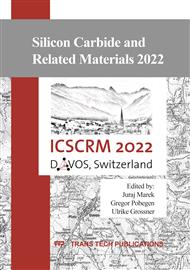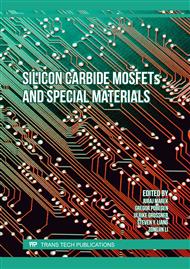p.101
p.107
p.113
p.119
p.127
p.135
p.141
p.147
p.153
The Influence of Extended Defects in 4H-SiC Epitaxial Layers on Gate Oxide Performance and Reliability
Abstract:
For the ongoing commercialization of power devices based on 4H-SiC, increasing the yield and improving the reliability of these devices is becoming more and more important. In this investigation, gate oxide on 4H-SiC was examined by time-zero dielectric breakdown (TZDB) and constant current stress (CCS) time-dependent dielectric breakdown (TDDB) method in order to get insights into the influence of the epitaxial defects on the gate oxide performance and reliability. For that purpose, MOS capacitors with different gate oxides have been fabricated. Crystal defects in the epitaxial layers have been detected and mapped by ultraviolet photoluminescence (UVPL) and interference contrast (DIC) imaging. The results of the comparison of electrical data and surface mapping data indicate a negative influence on the leakage current behavior for some extended epitaxial defects. Results from TDDB measurement indicated numerous extrinsic defects, which can be traced back to gate oxide processing conditions and defect densities.
Info:
Periodical:
Pages:
127-133
Citation:
Online since:
May 2023
Authors:
Keywords:
Permissions:
Share:
Citation:



